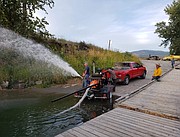Firefighters build equipment to meet needs of community
COPELAND — Firefighters use a lot of water for efforts aimed at extinguishing many of the types of fires inherent within this geographical area. According to insider.com, Class A types of fire fueled by materials like wood, paper, clothing, trash or plastics are able to be fought with water to douse the fire and remove the heat.
Common class A fires are easily controlled using water, but what happens when you live in a rural area without hydrants for fire trucks to hook up to in order to save your home, belongings or property?
Hall Mountain Fire Chief Brad Lowther was faced with this type of water supply problem.
“One of Hall Mountain Fire’s biggest challenges, over the years, has been water supply,” Lowther said. “There are no fire hydrants in the Hall Mountain fire district.”
With no fire hydrants in the district, the fire department must search for other viable water sources. According to Wildfire Today, sources such as water tanks, relay tanks, wells, springs, streams, and lakes are some alternate water supply options.
“There is, however, the Kootenai River and many lakes and streams to draft from, and drafting is how the department gets much of its water for fighting fire,” said Lowther.
In the case that there is no hydrant to receive pressurized water, firefighters must pull water from the other water supply options, which is known as drafting.
A plan was originally put into place in 2014 to ensure that Hall Mountain Fire is able to provide water to the community in which they serve.
The fire department began with a purchase of an AM General tractor, which is a military surplus vehicle, in 2014, with intentions to build a water tender.
“The department picked up a military surplus tractor from Idaho Department of Lands through the Federal Excess Personal Property program,” said Lowther. “A 4,000-gallon water tank and pump was installed on that truck chassis and the search began for a tanker trailer to be pulled by the AM General.”
“After much searching a 7,400 gallon aluminum tank trailer was found in MacGregor Manitoba,” said Lowther.
After purchasing the trailer, Ben Allinger, went to pick it up; lending to the creation of Hall Mountain’s, Water Tender 31.
When using Water Tender 31, firefighters were forced to use a portable pump that they had to carry on the tender in order to offload the water.
“During the summer of 2018, Hall Mountain decided to build a pump trailer that would serve as a mobile fire hydrant that could supply a large volume of water on larger incidents to multiple vehicles via drafting,” said Lowther.
The department was able to purchase a new Kubota industrial diesel engine from Idaho Federal Surplus along with a pump from Panhandle Pump.
“With those two core components, Bill Branson spent most of his summer building this unit from the ground-up, including the trailer itself,” said Lowther. “The end result was dubbed, Hydrant One.”
“The pump will deliver over 600 gallons per minute out of four, 2½-inch discharges,” said Lowther, “The unit (Hydrant One), also has an LED light tower for nighttime operations.”
“This last year, Bill Branson, once again, used up most of his summer mounting a diesel driven pump on the trailer,” said Lowther. “An Isuzu, industrial engine, purchased from Idaho Federal Surplus, combined with a pump, purchased from Panhandle Pump, became the business end of the trailer.”
After these modifications to the water tender and in upgrading its capabilities to provide water tending services in the ways in which the Hall Mountain District would need.
“This tanker can fill multiple apparatus simultaneously,” said Lowther. “Although the tanker cannot make it up all driveways, it just needs to be closer than the nearest water source.”
Lowther said, “It has already proven its worth to the department. Now, instead of wasting manpower to set up and fill a water tender, that manpower can be used to fight fire.”



